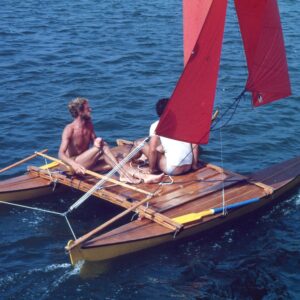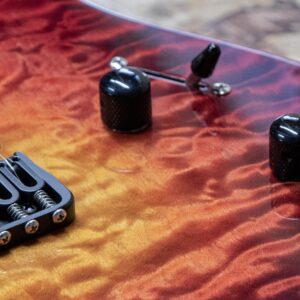How To: How Can Epoxy Fillets Enhance the Strength of Your Boat’s Structure?
Epoxy fillets can make a bond between components even stronger than the components themselves, ensuring that loads can be transferred between structures and panels effectively, with no risk of stress fractures or other structural issues. In this blog, David Johnson explains what they are and how they work. Following by the five steps that are the hallmark of a perfect fillet.
All wooden boat builders need to create strong, durable bonds between the inside of the hull and structural components such as bulkheads and stiffeners. Critically, these bonds must be capable of transferring large cyclic loads between panels and components, leaving no weak spots anywhere.
Epoxy fillets really can be stronger than the components themselves.
For modern boat builders, the best way to create strong bonds between structural components is to reinforce them with epoxy ‘fillets’. These are formed with thickened so-called ‘radiused’ epoxy on the inside corner of wood junctions and are often used where plywood parts join, such as planking junctions, or where bulkheads and stiffeners mate to the hull.
In the past the ‘stitch and tape’ method of boatbuilding brought many designs, both power and sail, to DIY kit or plan build to worldwide use. This method used copper twisted wire to hold panels together and subsequently glass fibre tape and polyester resin as a means of making structural joints. However, the fact that polyester resin doesn’t bond well to wood negatively impacted quality and durability, increasing the risk of structural weaknesses and increasing the risk that expensive, in-use maintenance and repairs were required.
In sharp contrast to polyester, an epoxy resin/hardener mix is characterised by its high tensile strength, durability and its excellent adhesion to wood. Epoxy fillets really can be stronger than the components themselves.
Filleting with epoxy also plays a key role in the ‘stitch and glue’ construction method for plywood boats, which is based on the principles of metal welding. First, panels are held together at key points using wires or cable ties. Epoxy fillets are then added along the entire length of the bonds to create strong, durable hulls that can also be sheathed with fibre reinforcement and epoxy if required.
Epoxy fillets can make a bond between components even stronger than the components themselves, ensuring that loads can be transferred between structures and panels effectively, with no risk of stress fractures or other structural issues. Here, we overview the five steps that are the hallmark of a perfect fillet.
What Is The Filleting Process?
1. Surface Preparation
Surfaces should be clean, dry, dust free, well abraded and free from contamination (see the WEST SYSTEM® User Manual for special treatment for difficult substrates such as oily woods). Make sure the joints are smooth without bumps of cured epoxy, as this will upset the shaping action of the mixing stick.
2. Priming (two-step bonding)
Priming the area where the fillet will be applied, using the resin/hardener mix, is what we would call ‘best practice’. This allows the mixed epoxy to wick into the surface wood fibres and ‘tack’ to create more accurately formed and structurally robust fillets.
3. Applying the epoxy to create a fillet
Applying the filleting mix neatly reduces clean up. Best results are achieved by piping the filleting mix into the angle between components using a plastic food bag with a hole cut in the corner. This allows you to fill right into the angle between components with zero air voids. You will need to apply a little more of the mix in the corner (see shaping fillets below).
4. Shaping the fillet
The fillet can be shaped using mixing sticks with rounded ends.
Care should be taken to draw the mixing stick to bisect the angle of the two components coming together and to hold the stick perpendicular to the work. This creates a symmetrical shape that will work efficiently to transmit loads between panels. Drawing the mixing stick along several times ensures the fillet has filled the joint.
When you come to a corner (three angles coming together) you will need to practise your technique, but essentially you just carry the fillet around the first angle, rotating the stick as it passes the angle, then come back and starting at the top of the fillet you have just created, draw the mixing stick up and away from the corner. Practice makes perfect.
Our WEST SYSTEM 804 reusable plastic mixing sticks have a radius of 10mm and are ideal for creating smooth symmetrical fillets . Larger fillets can be made using wood or plastic with rounded ends. Some CNC plywood kits have a selection of rounded-end sticks pre-machined as part of the kit.
5. Cleaning up the fillet
It is possible, at this stage, to apply glass reinforcement over the fillet.
For the most robust structure we would suggest a biaxial fabric reinforcement. These fibres can be draped across the fillet joint at a sympathetic angle with both orientations of fibres, albeit slightly off axis, contributing to tensile or compressive strength.
Woven tape has fibres at 0°/90° and as such will always have one redundant (warp orientation) run of fibre.
To reduce time sanding and removing dust and amine blush, WEST SYSTEM Peel Ply Tape, available in 50mm or 100mm widths, should be applied over the shaped fillet. Pre-cut this into short overlapping strips, this will make application very easy. Once the fillet is cured, the peel ply can be pulled away, leaving a fair, graded finish that is an exact impression of the weave of the peel ply. Because of this textured finish there is little or no sanding required. This has the additional advantage of removing any amine blush with the peel ply.



